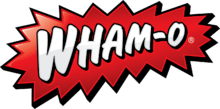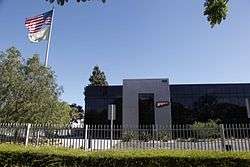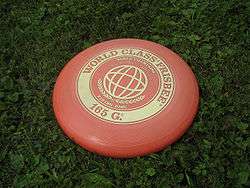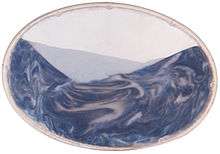Wham-O
 | |
| Private | |
| Industry | Toys |
| Founded | 1948 |
| Founder | Richard Knerr and Arthur "Spud" Melin |
| Headquarters | 966 Sandhill Ave, Carson, CA 90746 |
Key people | Todd Richards: President |
| Website | http://www.wham-o.com/ |

Wham-O Inc. is an American toy company headquartered in Carson, California, United States. They are known for creating and marketing many popular toys for nearly 70 years, including the Hula Hoop, the Frisbee, the Slip 'N Slide, the Super Ball, the Trac-Ball, Silly String, the Hacky Sack, and the Boogie Board.[1]
Corporate history
Richard Knerr and Arthur "Spud" Melin, a native of South Carolina, two University of Southern California college graduates unhappy with their employment, began the company in 1948 as "WHAM-O Mfg. Co." in the Knerr family garage in South Pasadena. Their first product was the Wham-O slingshot, made of ash wood, which Knerr and Melin would promote by showing off their own skills at demonstrations. The powerful slingshot was used by clubs for competitive target shooting, as well as for small game hunting.[2] The name "Wham-O" was based on the sound of the slingshot's shot hitting the target.[3] When they outgrew the garage, they rented a building on S. Marengo Ave in Alhambra, California; in 1955, the company eventually moved its manufacturing plant to neighboring San Gabriel, California.
Timeline
- 1948: WHAM-O founded — For about a year in the fifties, the company tries to brand their sporting goods under the name WAMO. The sporting goods buyers don't care for the switch, so it is soon dropped.
- 1957: WHAM-O acquires the rights to the Flyin-Saucer / Frisbee from Fred Morrison.
- 1958: Hula Hoop first marketed by WHAM-O.
- 1958: the Hula Hoop craze occurs.[5]
- 1958: Flying Saucer / Frisbee sales improve.
- 1961: Slip 'N' Slide first manufactured by WHAM-O.
- 1965: Super Ball first manufactured by WHAM-O.
- 1982: Wham-O was purchased by Kransco Group Companies.
- 1994: Mattel buys Wham-O from Kransco.
- 1995: Wham-O buys Aspectus.
- 1997: Wham-O becomes independent again when a group of investors purchases the company from Mattel.
- 2002: Arthur "Spud" Melin dies.
- January 2006: Wham-O is sold for ~ US$80 million to Cornerstone Overseas Investment Limited, a Chinese company that owns or controls five factories in China. That same month, Wham-O donates the office files, photographs and films of Dan "Stork" Roddick (Dir. Sports Promotion 1975–1994) to Western Historical Manuscript Collection (Midwest Disc Sports Collection accession 5828). WHMC is located on the University of Missouri, Columbia campus, and is a joint collection with the State Historical Society of Missouri.
- 2008: Richard Knerr dies.[6]
- 2008: Wham-O introduces the EZ Spin Foam Frisbee Disc (a waterproof foam disc with plastic center for spinning of disc on top or bottom of disc).
- 2009: Wham-O is sold to investment firm The Aguilar Group.[7]
- 2010: Wham-O acquires Sprig Toys Inc.[8]
- 2015: StallionSport Ltd. and InterSport Corp. acquires the global rights to Wham-O Inc.
Products and marketing

In 1957, Wham-O, still a fledgling company, took the idea of Australian bamboo "exercise hoops" and manufactured them with Marlex. The new Hula Hoop was born (the name "hula hoop" has been used since the 18th century). Knerr and Melin had created the biggest fad to date.[9][10] Twenty-five million were sold in less than four months, and in two years sales reached more than 100 million units.[11] By the end of 1959, after US$45 million in profits (US$346M adjusted for inflation to 2012), the fad slowly was dying out.
Shortly after, they had success again with the Frisbee. In 1955, Fred Morrison began marketing a plastic flying disc which he called the "Pluto Platter Putt-Putt". He sold the design to Wham-O in 1957 and the design was modified, the product renamed "Frisbee," and sales took off in 1959.
In the early 1960s, Wham-O created the Super Ball. It was made of a relatively hard elastomer Polybutadiene alloy dubbed Zectron, exhibiting a 0.92 coefficient of restitution when bounced on hard surfaces. The company sold some 20 million of these during the 1960s, and the NFL named the Super Bowl games after it.[12]
The Frisbee and Hula Hoop created fads. Other products tried to take advantage of existing national trends. In the 1960s, Wham-O came out with a US$119 do-it-yourself bomb shelter cover. In 1962, they sold a limbo dance kit to take advantage of that fad, and in 1975 when the movie Jaws was released, they sold plastic shark teeth.
Many products, of course, were not successful. One such product came as a result of Melin's safari to Africa in the early 1960s. While camping, he discovered a species of fish that laid eggs in the mud during Africa's dry season. When the rains came, the eggs hatched and fish emerged overnight. Melin turned this into the Instant Fish product, an aquarium kit that consisted of some of the fish eggs and some mud in which to hatch them. Its debut at a New York toy fair made it wildly popular, but the fish could not produce eggs fast enough, so the idea was dropped.
Other products

- Wheelie Bar (1966) for wheelie bikes, especially well suited for the popular Schwinn Sting-Ray. The packaging featured 1960s icon Rat Fink, and the image was widely distributed on T-shirts, posters, and decals. The television commercial featured Kathryn Minner, the original Little Old Lady from Pasadena.
- "Air Blaster" (1965), which could blow out a candle at 20 feet.[13]
- "Bubble Thing" (1988), soap bubble toy, which is an extremely large bubble wand, usually dipped in a small plastic wading pool filled with bubble solution that claims to make bubbles "as long as a bus," .
- "Huf'n Puf" blowgun, which shot soft rubber darts, a gentler version of the real thing[14]
- Wham-O also marketed very real crossbows, machetes, boomerangs, throwing knives [15][16]
- A "Powermaster" .22 caliber single-shot target pistol sold by mail order (1956)[17] and several other .22 caliber weapons
- Slip 'N Slide (1961)
- Water Wiggle (1962)[18]
- Monster Magnet (1964)[19]
- Super Sneaky Squirtin' Stick (1964)[20]
- Willie (1964) a toy furry snake [21]
- Super Ball (1965)[22]
- Super Stuff (1966)[23]
- Giant Comics (1967)[24]
- Silly String (1969)
- Super Elastic Bubble Plastic (1970)
- Magic Window (1971), was made from two 30 by 30 centimetres (12 in × 12 in) oval plates of heavy clear plastic, with a narrow channel between them containing "microdium" (glass) crystal sands of varying colors. The concept behind the Magic Window toy came from inventor Roy L. Cloutier, who had a degree in Engineering Physics from Michigan Tech.[25] In 2012, the current owners of the original patent made a slightly modified version of the Magic Window available, created and marketed without Wham-O's involvement.[26]
- Trac-Ball
- Magic sand (1980)
- Roller Racer Sit Skate (1983)
- Hacky Sack, footbag product design was purchased from its inventors in 1983
- Splatter Up (1990s)
- EZ SPIN Foam Frisbee Disc (2008)[27]
Strategy
Wham-O's initial success can be seen as a result of the insight of its founders. Knerr and Melin aimed their products directly at kids, going to playgrounds to reach them. They did extensive research to find new product ideas, including traveling around the world.[28]
For many years, the company's strategy was to have eight to twelve simple and inexpensive products, such as Frisbees, Band-Aids, Super Balls, and Hula Hoops. New products would be developed and added to the line for a tryout period, and old ones retired (either for a few years or permanently) as their popularity waned. Since the toys were not expensive or complicated, they were sold by a wide variety of retailers, from large department stores to five and dime stores.
After the sale of the company, the various new owners experimented with changes to this formula. The toy industry was changing, with more complicated products and fewer sales outlets.
As of 2006, the portfolio of product lines includes several groups of related items which use licensed brand names. For example, Sea-Doo is a brand name by the manufacturer Bombardier of personal water craft; Wham-O makes a "Sea-Doo" product line of small inflatable rafts designed to be towed behind watercraft.
Product lines are also more complex, and are grouped into related categories; the Sea-Doo line has approximately a dozen products, there are several Slip 'N Slide variations, a group of "lawn games" and so on.
On January 31, 2011, Wham-O announced its arrangement with ICM, the company that represents Atari video games, to represent the Wham-O company in various media. The expected result will be movies, television, music, and online content based around the toy products of the Wham-O company.[29]
As of 2017, Wham-O is focused on creating recreational products that are fun to use and motivate youth to be more active outdoors. Their hope is that through Wham-O products, kids will learn to be more adventurous and inventive while creating unforgettable memories along the way. Yet, in order to effectively reach young consumers in a modern marketplace, Wham-O is realistic about its need of technology in its marketing strategies. Wham-O's marketing strategy focuses on reaching consumers on various digital platforms, namely social media, as a means of motivating them to play outside and share their experiences with others online.
References
- ↑ "Toy Industry News!". Toydirectory.com. Retrieved 2016-08-03.
- ↑ Robert Hertzberg (April 1951). "Return of the Giant Killer". Mechanix Illustrated.
- ↑ Wham-O. "History". Archived from the original on 2013-02-18. Retrieved 22 Apr 2011.
- 1 2 John Jacobs (November 19, 1992). "Ad Executive Tells How Bush "Blew' Election Cites Failure To Come Up With A Coherent Message". San Francisco Examiner. p. A18.
- ↑ International Directory of Company Histories (Vol.61 ed.). St. James Press. 2004.
|access-date=requires|url=(help) - ↑ "Wham-O co-founder Knerr dies at 82 - San Francisco Business Times". Retrieved 3 August 2016.
- ↑ "Archived copy". Archived from the original on 2009-08-27. Retrieved 2009-10-29.
- ↑ Said, Carolyn (2010-03-08). "Nostalgia (and Frisbees) in the air at Wham-O". San Francisco Chronicle. Retrieved 2010-03-08.
- ↑ Brymer, Chuck (2008). The nature of marketing: marketing to the swarm as well as the herd. Palgrave Macmillan. p. 22.
- ↑ Olson, James Stuart (2000). Historical dictionary of the 1950s. Greenwood Publishing Group. p. 136.
- ↑ International Directory of Company Histories (Vol.61 ed.). St. James Press. 2004.
|access-date=requires|url=(help) - ↑ "Super Bowl Owes Its Name to a Bouncy Ball - History in the Headlines". History.com. 2012-02-03. Retrieved 2016-08-03.
- ↑ "The History of Wham-O". Wham-o.com. Archived from the original on 18 February 2013. Retrieved 12 February 2013.
- ↑ "12 Lesser-Known Wham-O Products You Have to See to Believe". Mental Floss. 2015-08-27. Retrieved 2016-08-03.
- ↑ p. 136 Walsh, Tim Timeless Toys: Classic Toys and the Playmakers Who Created Them Andrews McMeel Publishing, 1 Oct. 2005
- ↑ p. 52 Popular Science Jan 1957
- ↑ by B.B. Pelletier (2006-01-13). "Airgun makers that spawned firearms | Air gun blog - Pyramyd Air Report". Pyramydair.com. Retrieved 2016-08-03.
- ↑ "Recall Of Wham-O Water Wiggle Toy". Cpsc.gov. Retrieved 3 August 2016.
- ↑ "Monster Super Gorilla Giant Horseshoe Magnet - by Wham-o". Onlinesciencemall.com. Retrieved 2016-08-03.
- ↑ Super Sneaky Squirtin Stick (1978-01-24). "Super Sneaky Squirtin Stick - Trademark #73131837, Owner: WHAM-O". Inventively.com. Retrieved 2016-08-03.
- ↑ p. 163 Catalog of Copyright Entries: Third series 1965
- ↑ Coopee, Todd. "Super Ball from Wham-O (1965)". ToyTales.ca.
- ↑ "View topic - Wham-O Super Stuff". OldKC.com. Retrieved 2016-08-03.
- ↑ "RETRO REVIEW: Wham-O Giant Comics #1 (April 1967)". Major Spoilers. Retrieved 2016-08-03.
- ↑ "MTU Physics - Alumni - Department History - Exhibits - BS Degrees". Phy.mtu.edu. Retrieved 2012-02-17.
- ↑ "Get Yourself a Magic Window, just like the popular 70's toy for all ages!". Magicwindows.org. Retrieved 2012-02-17.
- ↑ EZ SPIN Foam Frisbee Disc
- ↑ "Branding In History:Fad and Brand – Wham-O®". marketingdoctor.tv. April 14, 2008. Archived from the original on February 16, 2009. Retrieved October 2, 2017.
- ↑ Kit, Borys. "EXCLUSIVE: ICM Signs Wham-O Toy Company". The Hollywood Reporter.
External links
- Wham-O Company website
- Flying Disc Time-Line
- Ken Westerfield — history of Frisbee and disc sports.